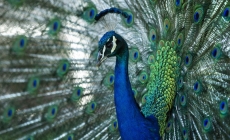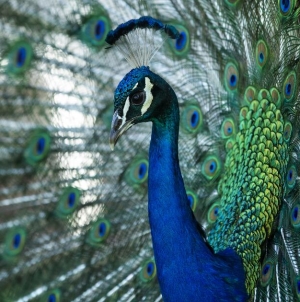-
Beloved peacocks reported stolen from historic California hotel - 6 hours ago
-
Judge Sentences Ex-Officer in Breonna Taylor Raid to Nearly 3 Years in Prison - 9 hours ago
-
Dozens Are Killed at Aid Site Near Border, Gaza Health Officials Say - 2 days ago
-
30 hurt when car slams into crowd in Hollywood - July 19, 2025
-
Astronomer CEO Andy Byron Placed on Leave After Video at Coldplay Concert Exposes Alleged Affair - July 19, 2025
-
Blood in the Streets and Death in the Air: Residents Survey Damage in Syrian City - July 17, 2025
-
Army vet calls for investigation after being detained for three days in ICE raid - July 17, 2025
-
Tariffs Push Up Prices, and the Supreme Court’s ‘Shadow Docket’ - July 16, 2025
-
ICE arrested her selling tamales at Lowes. Then she suffered a heart attack. ‘I told them: I can’t breathe’ - July 14, 2025
-
The Royal Box: Who’s in Wimbledon’s Most Exclusive Seats? - July 13, 2025
In Shetland, the Hottest Event of the Year Stars Sheep and Knitters
The sheep came spilling over the hillside, emerging through the low mist where the green earth touched the gray sky, running down into the fields below.
They were ready for their big moment.
It was Shetland Wool Week, and visitors from around the world — most of them women and nearly all of them knitting enthusiasts — were streaming to the Uradale farm and other areas of the Shetland Islands, a far-flung archipelago north of the Scotland mainland, to see the famed fleeces.
The weeklong festival, established in 2010, is both a way to spread a cherished tradition of knitting and celebrate the local culture, and a commercial opportunity for the area’s sheep farmers, wool spinners and craftspeople.
“What Shetland Wool Week did was offer us a shop window to an international audience, which we probably would have had great difficulty finding,” said Ronnie Eunson, who established Uradale Farm decades ago. “It’s a whole new world, these ladies who knit.”
But it is also a celebration that every year transforms the remote island communities into a hub of woolly activity.
Across the islands, knitters were everywhere, with the rhythmic click of metal needles providing the background soundtrack to island life.
Over dinner in one restaurant, two women compared notes about the type of yarn to use in a sweater design. In a cafe on one of the more remote islands, three friends pulled out their knitting needles as they shared a coffee. In a hotel lounge in Lerwick, Shetland’s main town, two women lamented the difficulty in getting tickets for the most popular courses on Wool Week’s website.
“The site crashed immediately, it was like a Beyoncé concert,” said Kate Hall, 56, on the day the 2023 dates were announced. Ms. Hall, a veterinarian from Toronto, traveled to Shetland with a friend after talking about coming for years.
This year, around 800 people attended the festival, with some 60 percent coming from outside Britain. The visitors were easy to spot in their woolen sweaters and hats of intricate patterns — the colorful designs of Fair Isle knitwear perhaps the most famous — as they visited farms, yarn shops, artist studios, community halls, high schools and people’s kitchens and living rooms across Shetland for tutorials, tours and talks. Some wore the Wool Week beanie — a new pattern shared with participants each year, who knit their own versions.
Many visitors made their way to Uradale Farm, which allowed Mr. Eunson, 65, and his son, Jakob, 26, to expound on their organic, sustainable ethos.
“It’s a fragile, precarious system,” the father said, of running the farm and its wool business. “But so is living on an island.”
As the sheep came down the hill, his son, his boots caked in mud, called out to the collies at the flock’s heels, using a series of whistles and commands as the dogs deftly prodded the sheep onward.
When a tour group arrived, the elder Mr. Eunson led the sheep into a holding pen as he explained the history of the Shetland breed. The smell of the livestock mingled with the brisk island air as the visitors listened intently.
Then they all warmed up inside with tea and biscuits before crowding into the small shop off the living room to see the finished product and run their hands along the colorful balls of yarn.
Mr. Eunson and his partner, Viveka Velupillai, talked their visitors through the different yarns and their Shetland names — like the flukkra, or snow, for one shade of white.
In the 1970s, an oil boom brought economic transformation to this cluster of islands in the North Sea, population of about 23,000. Many Shetlanders left the small-scale farming and fishing that had long defined life here.
But the Shetland’s knitting heritage hung on. And these days it is thriving, and adapting.
Many of the skilled knitters here share their designs online and have a wide reach on social media where they garner a large, if still niche, following in the global knitting community, which has only grown since a surge in interest during the pandemic.
Alison Rendall, a 57-year-old nurse who was born in the Shetlands and learned to knit from her grandmother, is this year’s patron of the festival. She said she has long been inspired in her own designs by Shetland’s stunning natural landscape.
Growing up, Ms. Rendall said the islands’ culture had often been looked down upon, with schools discouraging students from speaking the local dialect, which some linguists say is a distinct language. The festival is one way to preserve what makes the Shetlands unique.
“Folk love that there is a unique culture here, and it’s important for us to hang on to that,” Ms. Rendall said.
At a pub in Lerwick, the biggest town on the islands, Judy Klevan tapped her feet to live traditional music as her hands moved swiftly along her knitting, which peeked out of a small cloth bag. Ms. Klevan, 64, and her husband, Mark Nigogosyan, 65, both doctors from Minnesota, sat across from two friends from Australia.
“It’s just an amazing festive atmosphere,” Dr. Klevan said. “And for me, it’s about seeing the creations other knitters have made.”
The next morning, travelers on a ferry to the island of Whalsay — a 30-minute ride from Shetland’s main island past the dramatic cliffs that dot the coastline — were decked out in their colorful beanies as they enjoyed their Wool Week sojourns.
“I am really happy to be here for the knitting, and he’s happy to wear the hats,” Pat Blain, 73, said with a laugh as she stood alongside her husband, Peter, 72.
On the island, Ann Marie Anderson was running classes from her craft shop, teaching visitors to needle felt wool.
“Being in such a peerie place like this,” she said, using the Shetland word for “tiny,” “they really get to experience island life. And I think there is something really special about it all, you get a real sense of this place.”
The pinnacle for many is the maker’s market held in the main high school on the festival’s penultimate day, where designers, producers and artists set up stalls and sell their goods.
The elder Mr. Eunson, wearing a smart green tweed jacket, and Ms. Velupillai together set up their stand with balls of yarn and design kits as dozens of people in knitted hats clustered outside.
Mr. Eunson said he takes pride that even though the island have been through the oil businesses “coming in to take what they need and go,” the wool culture indigenous to Shetland remains on good footing.
But he knows there is a delicate balance between fostering an appreciation for that heritage and sustainable growth.
“It’s not a static culture,” he said. “But it doesn’t need to become a mass-produced thing as well. It can still all be done in Shetland.”









